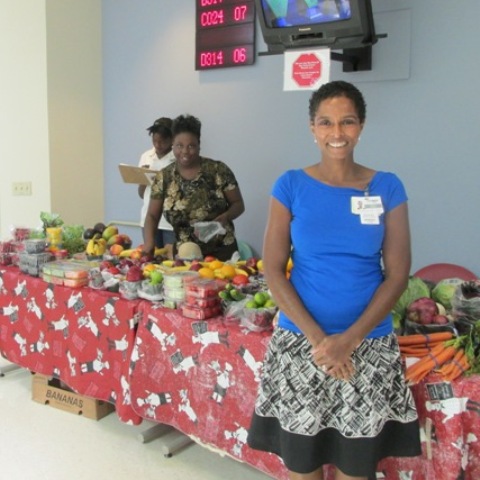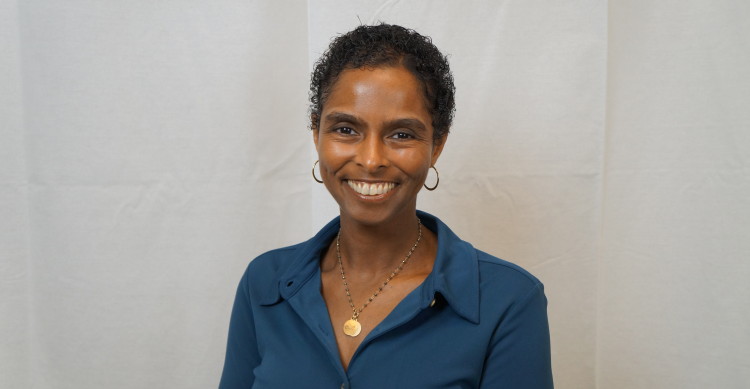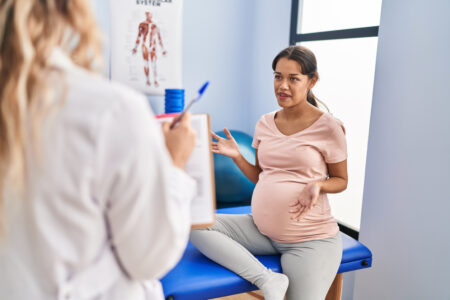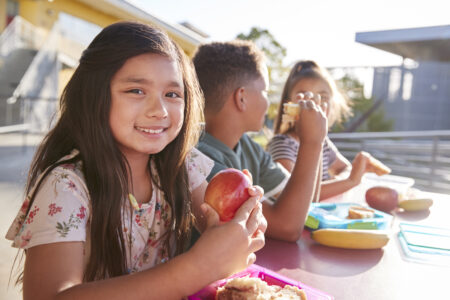Share On Social!
Dr. Ann Barnes talks to her patients daily about their health.
When Barnes, an associate professor at Baylor College of Medicine in Houston and Chief Medical Officer of Legacy Community Health, advises them to eat more fruits and vegetables, she hears common excuses.
“‘It’s too expensive, there’s nowhere near my house [to buy fresh produce].’ That was weighing on me as a clinician,” Barnes said.

Barnes was worried some of her low-income patients would return to her office with illnesses or worse—pre-diabetes, heart problems, cancer—if they continued to not have access to fresh, healthy foods that would help them prevent disease.
Then she had a revelation.
Big Idea: Farmer’s Market at the Clinic
Houston, Texas, where nearly half the population is Latino, community health clinics are where many low-income families receive medical attention and yearly check-ups.
Yet the neighborhoods around these clinics tend to lack access to fresh fruits and vegetables.
Having been to farmers’ markets in the past, Barnes knew how beneficial it can be for a community to have fresh produce brought right into a neighborhood.
“I had sort of a revelation moment in the middle of the night and I said, ‘We need to bring farmers’ markets to the clinics,’” she said.
So Barnes did some research.
She wanted to find out who had brought farmers’ markets to clinics in the past. She searched online and found a few farm-to-hospital programs, but these mostly were for the benefit of the employees. She found a few instances where hospitals and clinics hosted health fairs that would sometimes feature a farmers’ market, but nothing regular or repeating.
She also noted that these types of farmers’ markets were never in minority or low-income areas where transportation to larger supermarkets is problematic.
She eventually learned that Kaiser Permanente, a non-profit health provider, implemented farmers’ markets in their hospitals. After helpful phone discussions with Kaiser Permanente officials and studying their in-depth resource guide, Barnes believed Houston were fertile ground for in-clinic farmers’ markets.
Barnes proposed her idea to David Lopez, the CEO of the Harris County Hospital District.
“I started at the top to make sure there was buy-in,” she said.
As it turns out, Lopez had been brainstorming ways to bring fresh produce into the clinics, too. He enthusiastically gave his approval, and Barnes set out to create a new way for low-income patients to get the fresh produce their bodies need to stay healthy and prevent disease.
How to Start a Farmer’s Market
First, Barnes needed to find produce vendors.
This process took about six to nine months, she recalled, and wasn’t easy. One large local farmers’ market showed interest, but not enough to commit. She reached out to a nearby agricultural university hoping they might have some connections that could provide the produce, but again they were hesitant. There was no guarantee that any of their produce would sell, and they didn’t have the man power to constantly be sending people into Houston.

Barnes tried to engage the Houston-area large grocery stores.
“We made the case that these are potential shoppers,” Barnes said, “and that by having a presence working with low-income populations, you might actually engender good will in those neighborhoods and increase your shopper base.”
No luck. Fortunately, during these conversations, one grocer pointed Barnes to Veggie Pals, a local, small non-profit that provides nutrition education and occasionally fresh produce to underserved communities. The grocer had been impressed with Veggie Pals president Renea Gray and her resourcefulness in implementing programs.
Barnes and Gray connected. Gray, who grew up in a lower-income Houston neighborhood, supported Barnes’ idea for in-clinic farmers’ markets.
Gray already had been bringing small amounts of fresh produce to low-income senior centers, so she had experience buying produce from vendors. Veggies Pals gets some of its produce from local farmers, but the majority from produce companies that also sell to grocery stores.
Gray and Barnes wanted to learn more about residents who lived around the clinics.
Gray and Veggie Pals volunteers went out into neighborhoods surrounding the clinics and surveyed residents. They wanted to make sure they were accounting for all the diverse needs, said Gray. They asked folks questions like: “What types of produce would you like to see being sold in your community?”, “How often do you go to the grocery store?” and “In what price range would you pay for fresh fruits and vegetables?” The answers to these questions helped Gray figure out many logistics, like what items to purchase and how much of each.
Opening Up the Market
Barnes met with Harris County Hospital District clinic leadership to get their buy-in and their recommendations of which clinics might be best-suited for a trial of the farmers’ market program.
Then she and Gray went into each of the 10 clinics recommended and told them what they wanted to do, how the markets would benefit the patients, the staff, and the surrounding community.
Clinic leaders endorsed the idea.
An article in the Houston Chronicle advertised the markets to the surrounding neighborhood.
“We had a couple of folks from the community walk in with the article in their hand [to buy produce], not just patients,” said Barnes.
Barnes had planned, but didn’t get a chance, to educate more of the “front line” of clinic personnel about the trial program so they could remind patients about the markets.
“It’s not the administrator who talks to patients when they come to the clinics that lets them know about the farmers’ market, it’s the nurses, it’s the doctors,” she said.
Still, she surmised it wouldn’t be hard for patients to see large tables full of fruits and vegetables in the front of a clinic
The in-clinic farmers’ market program, named “Healthy Harvest,” launched in November 2011 in 10 trial clinic locations in the Harris County Hospital District.
In the chosen clinics, officials set up a few tables in a highly visible area outside in the lobby of the clinic. Veggie Pals would buy the produce and bring it to the clinic on market day, displaying all the fresh choices like broccoli, squash, oranges, and bananas. Gray would man the tables and sell the produce, sometimes with help of Harris Health System volunteers.
In addition to the fresh produce at the in-clinic farmers’ markets, on many occasions volunteers were on hand to offer nutrition assistance, sometimes dressed up as vegetables.
The 2011-2012 program sold more than 5 tons of food in 10 months.
This success led Barnes to apply for and receive a USDA grant to promote farmers’ market in communities. She believed that the extra funding would make future market programs even more successful.
Barnes, Gray, and clinic administration decided to do the markets again for 2013-14.
How it Worked
Operationally, food vendors are in charge of setting up their space and manning the stands. Clinic cleaning staff making sure that when the markets are done and the vendors are gone, the space is free of any debris.
For the 2013-14 program, five locations were chosen with the heaviest foot traffic during the trial. Barnes also considered which clinics were located in a USDA food desert, an area with no grocery store or fresh food outlet within a 1-mile walking distance. She wanted to be sure that needy areas got access to fresh fruits and vegetables.
The prices customers find at the clinic farmers’ markets are what you might see in your everyday grocery store. Barnes hopes that it’s the convenience that keeps customers returning.
A few of the many fresh options found regularly at Healthy Harvest markets.
Gray says they also try to bring in foods that fit in with the community’s culture. She says they carry many Latino traditional foods, including avocados and many kinds of peppers.
The clinics do accept cash and Lone Star food assistance.
Through the USDA marketing grant, Healthy Harvest hopes to attract more customers.
And as the markets draw more customers, Barnes hopes that they will make enough money to keep the markets self-sustaining.
“That’s my prayer; that we would be able to continue the markets.” Right now, she said, Veggie Pals breaks about even after accounting for costs and revenue.
Personally, Barnes is excited that the medical field is beginning to tie health to what patients eat more explicitly. She hopes the future brings other innovative programs, like written prescriptions for fruits and vegetables, into every community.
It’s all about a culture change, she said.
“Being able to tell [patients] to eat more veggies and then point them down the hall to buy some.”
Explore More:
Healthy FoodBy The Numbers
1
Supermarket
for every Latino neighborhood, compared to 3 for every non-Latino neighborhood
This success story was produced by Salud America! with support from the Robert Wood Johnson Foundation.
The stories are intended for educational and informative purposes. References to specific policymakers, individuals, schools, policies, or companies have been included solely to advance these purposes and do not constitute an endorsement, sponsorship, or recommendation. Stories are based on and told by real community members and are the opinions and views of the individuals whose stories are told. Organization and activities described were not supported by Salud America! or the Robert Wood Johnson Foundation and do not necessarily represent the views of Salud America! or the Robert Wood Johnson Foundation.



